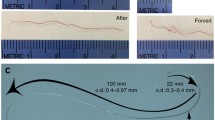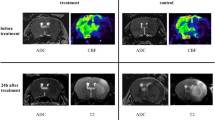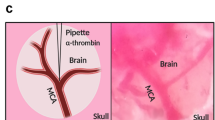Summary
The role of tissue-type plasminogen activator (rt-PA) during thrombolysis of stroke is poorly understood. Recently, a direct neurotoxic effect of rt-PA was reported. This is at odds with studies that show an improved outcome. Here we investigated the effect of rt-PA after failure to recanalize the occluded brain vessel. SpragueDawley rats underwent thromboembolic stroke. They were assigned to four groups according to the patency of the middle cerebral artery on cerebral x-ray angiography after treatment with saline or rt-PA (15 mg/kg body weight over 90 min, starting 1 h after embolization): (1) control without recanalization (n = 5), (2) rt-PA treatment without recanalization (n = 5), (3) control with spontaneous recanalization (n = 2), and (4) rt-PA treatment with recanalization (n = 3). Six sets of diffusion-and perfusion-weighted (bolus-track) magnetic resonance images were acquired throughout the 6-h observation period. When recanalization was successful, rt-PA significantly improved perfusion values and the final infarct size. However, final infarct volumes in nonrecanalized rt-PA-treated animals compared to control animals were 67.4% ± 5.4% versus 47.7% ± 17.9% of the ipsilateral hemisphere (P = 0.042) at corresponding perfusion values. Our results suggest that rt-PA treatment worsens outcome in a model of thromboembolic stroke if recanalization is not successful.
Access this chapter
Tax calculation will be finalised at checkout
Purchases are for personal use only
Preview
Unable to display preview. Download preview PDF.
Similar content being viewed by others
References
Wang YF, Tsirka SE, Strickland S, et al (1998) Tissue plasminogen activator (tPA) increases neuronal damage after focal cerebral ischemia in wild-type and tPA-deficient mice. Nat Med 4:228–231
Busch E, Kruger K, Allegrini PR, et al (1998) Reperfusion after thrombolytic therapy of embolic stroke in the rat: magnetic resonance and biochemical imaging. J Cereb Blood Flow Metab 18:407–418
Busch E, Kruger K, Hossmann KA (1997) Improved model of thromboembolic stroke and rt-PA induced reperfusion in the rat. Brain Res 778:16–24
Beaulieu C, Busch E, Rother J, et al (1998) Polynitroxyl albumin reduces infarct size in transient focal cerebral ischemia in the rat: potential mechanisms studied by magnetic resonance imaging. J Cereb Blood Flow Metab 18:1022–1031
Back T, Hoehn-Berlage M, Kohno K, et al (1994) Diffusion nuclear magnetic resonance imaging in experimental storke: correlation with cerebral metabolites. Stroke 25: 494–500
Tsirka SE, Gualandris A, Amaral DG, et al (1995) Excitotoxin-induced neuronal degeneration and seizures are mediated by tissue plasminogen activator. Nature 377:340–344
Tsirka SE, Rogove AD, Strickland S (1996) Neuronal cell death and tPA. Nature 384:123–124
Tsirka SE (1997) Clinical implications of the involvement of tPA in neuronal cell death. J Mol Med 75:341–347
Chen ZL, Strickland S (1997) Neuronal death in the hippocampus is promoted by plasmin-catalyzed degradation of laminin. Cell 91:917–925
Korninger C, Cohen D (1981) Studies on the specific fibrinolytic effect of human extrinsic (tissue-type) plasminogen activator in human blood and in various animal species in vitro. Thromb Haemost 46:561–565
Author information
Authors and Affiliations
Editor information
Editors and Affiliations
Rights and permissions
Copyright information
© 2001 Springer Japan
About this paper
Cite this paper
Busch, E., Beaulieu, C., De Crespigny, A., Wiegand, F., Moseley, M.E. (2001). MRI Demonstrates that Tissue-Type Plasminogen Activator Increases Stroke Volume if Cerebral Arteries Are not Successfully Recanalized. In: Fukuuchi, Y., Tomita, M., Koto, A. (eds) Ischemic Blood Flow in the Brain. Keio University Symposia for Life Science and Medicine, vol 6. Springer, Tokyo. https://doi.org/10.1007/978-4-431-67899-1_52
Download citation
DOI: https://doi.org/10.1007/978-4-431-67899-1_52
Publisher Name: Springer, Tokyo
Print ISBN: 978-4-431-67990-5
Online ISBN: 978-4-431-67899-1
eBook Packages: Springer Book Archive




